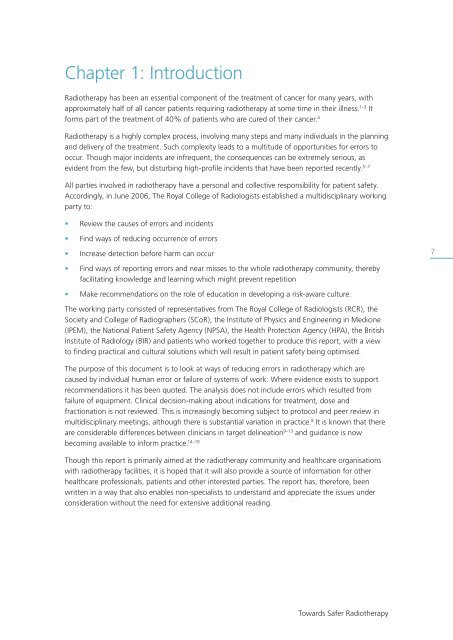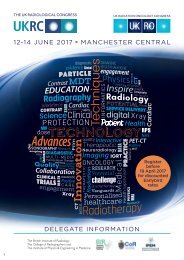Towards Safer Radiotherapy
Towards Safer Radiotherapy
Towards Safer Radiotherapy
Create successful ePaper yourself
Turn your PDF publications into a flip-book with our unique Google optimized e-Paper software.
Chapter 1: Introduction<br />
<strong>Radiotherapy</strong> has been an essential component of the treatment of cancer for many years, with<br />
approximately half of all cancer patients requiring radiotherapy at some time in their illness. 1–3 It<br />
forms part of the treatment of 40% of patients who are cured of their cancer. 4<br />
<strong>Radiotherapy</strong> is a highly complex process, involving many steps and many individuals in the planning<br />
and delivery of the treatment. Such complexity leads to a multitude of opportunities for errors to<br />
occur. Though major incidents are infrequent, the consequences can be extremely serious, as<br />
evident from the few, but disturbing high-profile incidents that have been reported recently. 5–7<br />
All parties involved in radiotherapy have a personal and collective responsibility for patient safety.<br />
Accordingly, in June 2006, The Royal College of Radiologists established a multidisciplinary working<br />
party to:<br />
• Review the causes of errors and incidents<br />
• Find ways of reducing occurrence of errors<br />
• Increase detection before harm can occur<br />
7<br />
• Find ways of reporting errors and near misses to the whole radiotherapy community, thereby<br />
facilitating knowledge and learning which might prevent repetition<br />
• Make recommendations on the role of education in developing a risk-aware culture.<br />
The working party consisted of representatives from The Royal College of Radiologists (RCR), the<br />
Society and College of Radiographers (SCoR), the Institute of Physics and Engineering in Medicine<br />
(IPEM), the National Patient Safety Agency (NPSA), the Health Protection Agency (HPA), the British<br />
Institute of Radiology (BIR) and patients who worked together to produce this report, with a view<br />
to finding practical and cultural solutions which will result in patient safety being optimised.<br />
The purpose of this document is to look at ways of reducing errors in radiotherapy which are<br />
caused by individual human error or failure of systems of work. Where evidence exists to support<br />
recommendations it has been quoted. The analysis does not include errors which resulted from<br />
failure of equipment. Clinical decision-making about indications for treatment, dose and<br />
fractionation is not reviewed. This is increasingly becoming subject to protocol and peer review in<br />
multidisciplinary meetings, although there is substantial variation in practice. 8 It is known that there<br />
are considerable differences between clinicians in target delineation 9–13 and guidance is now<br />
becoming available to inform practice. 14–19<br />
Though this report is primarily aimed at the radiotherapy community and healthcare organisations<br />
with radiotherapy facilities, it is hoped that it will also provide a source of information for other<br />
healthcare professionals, patients and other interested parties. The report has, therefore, been<br />
written in a way that also enables non-specialists to understand and appreciate the issues under<br />
consideration without the need for extensive additional reading.<br />
<strong>Towards</strong> <strong>Safer</strong> <strong>Radiotherapy</strong>



